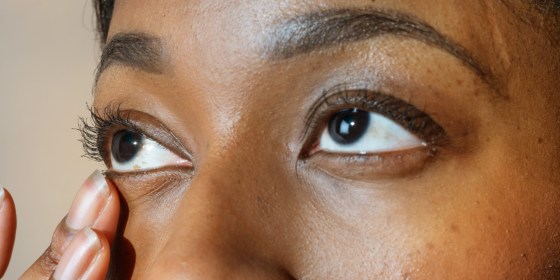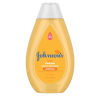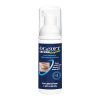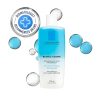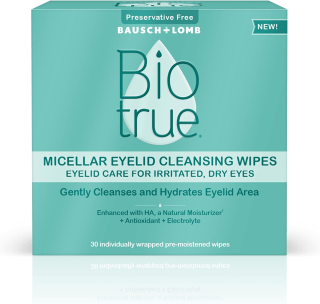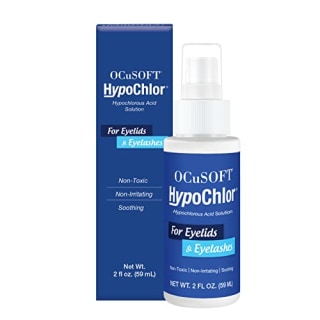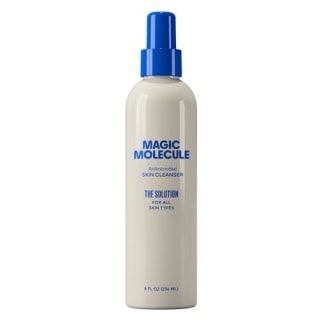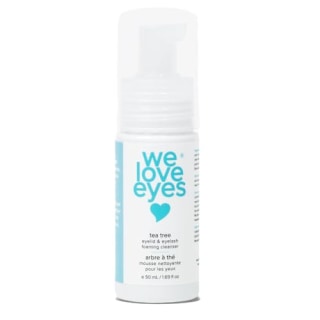If you’ve ever encountered what looked like a pimple along your eyelid, chances are you’ve had a stye. The best way to address one is by keeping the eyelid clean and moisturized — just like the rest of your face. That’s because a stye, while not technically a pimple, is similar to one in that it’s caused by a clog. “A stye is caused by a blockage of the eyelid oil glands, or meibomian glands, that leads to a bacterial infection,” says board-certified dermatologist Dr. Carmen Castilla. “It looks like a red swollen bump along the eyelash line — similar in appearance to a pimple.”
Like a pimple, you shouldn’t pop styes. (And unlike a pimple, there’s no equivalent of, say, an acne spot treatment.) Rather, we talked to dermatologists who say that washing the eyelid with a gentle cleanser, removing makeup and using a warm compress are your best bets for healing and preventing styes. If you really want to try other options, we talked to experts about products that won’t further irritate the eye area and could possibly help target the bacteria at the source of an infected stye, though they ultimately won’t change the trajectory of a stye — it still needs to run its course.
SKIP AHEAD How I picked the best stye treatments | The best stye treatments in 2025 | How to shop for stye treatments | Why trust NBC Select?
How I picked the best stye treatments
After speaking with three board-certified dermatologists, I sought out stye treatments that met a few standards: They need to be gentle enough not to irritate an existing stye and able to keep the eye comfortable while it heals. While these won’t necessarily make it disappear more quickly, they’ll keep your eyes much more comfortable while you wait it out. Here’s what else experts recommend I look for in a stye treatment:
- Hypoallergenic: Since allergens can cause further irritation, hypoallergenic labels are worth looking for.
- Fragrance-free: Fragrance can be a common irritant, so look for fragrance-free formulas for anything you put near your eye.
- Oil base: Oil-based products, like cleansing balms, are better able to break down longwear eye makeup, like waterproof mascara.
Want more from NBC Select? Sign up for our newsletter, The Selection, and shop smarter.
The best stye treatments in 2025
Johnson & Johnson Baby Shampoo
- Gentle
- Tear-free
- Hypoallergenic
- Nothing to note at this time
Three dermatologists I talked to recommended this shampoo to cleanse an eye with a stye. Castilla likes that it’s formulated not to sting, “so you don’t have to worry about a little bit getting in your eye,” she says. It lathers quickly and rinses easily, too, according to Johnson & Johnson. Board-certified dermatologist Dr. Bruce Robinson, recommends putting a capsule-worth of the baby shampoo in about 30 ounces of water, then using the solution to dampen a cloth or cotton pad and let it sit for 30 seconds on the affected eye.
Key ingredients: glycerin | Fragrance-free: yes
Ocusoft Lid Scrub Original Foaming Eyelid Cleanser
- Non-irritating
- Gentle
- Antibacterial
- Can't remove waterproof makeup
Board-certified dermatologist Dr. Brendan Camp likes that this cleanser can remove oil, debris, pollen and makeup from the eyelids, and says that you can get them as pre-moistened pads as well, which are good for travel. The formula has polyaminopropyl biguanide in it, which is a preservative that has antibacterial properties, therefore killing the bacteria contributing to the irritated eye area. It’s gentle enough for daily use and safe for contact lens wearers, too, according to the brand.
Key ingredients: polyaminopropyl biguanide, cocamidopropyl hydroxysultaine (coconut-based cleanser) | Fragrance-free: yes
Biotrue Micellar Eyelid Cleansing Wipes
- Moisturizing
- pH-balanced
- Safe for daily use
- Nothing to note at this time
I’ve used Bausch & Lomb’s contact lens solution for years, so when the brand sent me these to try, I was game to test them. I have sensitive eyes that get dry throughout the day (and have had styes in the past), and I liked that these didn’t irritate them whatsoever — but were still powerful enough to remove my waterproof mascara. They have hyaluronan, a humectant naturally found in tears related to hyaluronic acid, as well as micelles, the cleansing agent used in micellar water.
Key ingredients: hyaluronan, aloe juice, licorice extract | Fragrance-free: yes
La Roche Posay Respectissime Eye Makeup Remover
- Removes waterproof makeup
- Non-irritating
- Safe for sensitive eyes
- Nothing to note at this time
In order to remove both water- and oil-based makeup (the latter being common among waterproof mascara and eyeliners), this cleanser has both a water phase and oil phase. Once you shake the bottle, they work together to remove waterproof makeup without rubbing or irritating sensitive skin, according to Camp, who recommends it.
Key ingredients: poloxamer (a gentle cleaning agent) | Fragrance-free: yes
Ocusoft HypoChlor Spray
- Non-irritating
- Targets bacteria
- Spray form easy to apply
- Nothing to note at this time
Hypochlorous acid is an antimicrobial substance, which is why you may see it recommended for acne-prone skin. But for styes in particular, “hypochlorous acid sprays formulated for the eyes can also be helpful,” says Castilla, who recommends this one as a good option. “They are nonirritating, and can decrease the bacteria on the eyelid and remove excess oil.” It has 0.02 percent hypochlorous acid and is gentle enough for everyday use, according to the brand.
Key ingredients: hypochlorous acid | Fragrance-free: yes
Magic Molecule The Solution
- Gentle
- Sting-free
- Multipurpose
- Nothing to note at this time
This hypochlorous acid spray has a 0.018% concentration, which is slightly less of that than other sprays on the market) and helps nix bacteria, reduce redness and generally calm skin, according to the brand. That was enough to convince NBC Select associate reporter Bianca Alvarez to try it for her eczema. “Aside from the fact it smells like pool water, it is simply perfection,” she says, explaining why it was her favorite product of 2024. “Every morning and night, I would spray this and not once did it burn, sting or worsen my condition; instead, it reduced my redness significantly, made my skin feel soothed and calmed the dry, itchy, flaky look and feel on my face.”
Key ingredients: hypochlorous acid | Fragrance-free: yes
We Love Eyes Tea Tree Eyelid Foaming Cleanser
- Antimicrobial
- Optometrist-formulated
- Gentle
- Contains essential oils
Developed by an optometrist, this foaming cleanser is designed to wash away bacteria, debris and allergens. It uses tea tree oil, which has natural antimicrobial properties, to cleanse the eyelid, as well as jojoba and grape-seed oils to moisturize the skin around the eyes, according to the brand. It has an average 4.5-star average rating from 3,032 reviews on Amazon.
Key ingredients: hypochlorous acid | Fragrance-free: yes
How to shop for stye treatments
When you’re trying to address a stye, keep in mind that treatments can’t necessarily make them heal faster. “They really don’t do much other than to ease some of the inflammation and discomfort,” says Robinson. “There are hydrating eye drops, there are medicated pads, there are cleansing solutions, but unfortunately none of them really change the trajectory — they just makes the stye more comfortable to deal with it until the blockage either relieves itself or you go to get it treated by a dermatologist.” On their own, styes typically resolve in one to two weeks, according to Castilla.
With that in mind, Robinson recommends making sure any product you use, be it a cleanser, a cleansing wipe or a spray, be hypoallergenic and free of fragrance, as these can potentially be irritating. “A gentle soap can help break down excess oil preventing a stye from worsening or spreading,” adds Castilla. “It also can also prevent worsening by washing away bacteria.”
Some have antibacterial agents, too, which can be helpful. Castilla particularly likes hypochlorous acid, since it’s gentle yet effective.
And finally, Robinson also recommends seeking out cleansers that have an oil base. “If you have an inflammatory condition on your skin, something more oily is more soothing and hydrating,” he says. “It’s more lubricating than a water base and may be more soothing when you take off your makeup.”
Meet our experts
At NBC Select, we work with experts who have specialized knowledge and authority based on relevant training and/or experience. We also take steps to ensure all expert advice and recommendations are made independently and without undisclosed financial conflicts of interest.
- Dr. Bruce Robinson, FAAD, is a board-certified dermatologist in New York, NY. He specializes in difficult-to-diagnose disorders of the skin, hair and nails as well as laser aesthetics and body contouring.
- Dr. Carmen Castilla, FAAD, is a board-certified dermatologist at New York Dermatology Group in New York, NY and clinical instructor at Mount Sinai Hospital. She focuses on both medical and cosmetic dermatology.
- Dr. Brendan Camp is a board-certified dermatologist at MDCS NY in New York, NY. He’s an expert in both medical and cosmetic dermatology and is also board-certified in dermatopathology.
Why trust NBC Select?
I am a freelance beauty writer and editor who’s been covering beauty and health for more than a decade, including writing about topics like at-home microcurrent devices and prebiotic skin care. For this article, I spoke to three dermatologists to find the best products for treating styes to shop this year, and highlighted their recommendations for the best options to consider.
Catch up on NBC Select’s in-depth coverage of tech and tools, wellness and more, and follow us on Facebook, Instagram, Twitter and TikTok to stay up to date.
